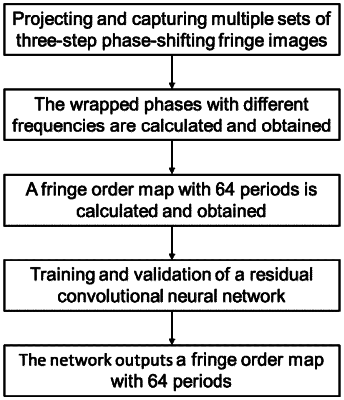| CPC G01B 11/25 (2013.01) [G06N 3/049 (2013.01); G06N 3/08 (2013.01)] | 6 Claims |

|
1. A deep learning-based temporal phase unwrapping method for fringe projection profilometry is characterized in that the specific steps are as follows:
step one, four sets of three-step phase-shifting fringe patterns with different frequencies (including 1, 8, 32, and 64) are projected to tested objects; the projected fringe patterns are captured by a camera simultaneously to acquire four sets of three-step phase-shifting fringe images;
step two, the three-step phase-shifting fringe images acquired by the camera are processed to obtain a wrapped phase map using a three-step phase-shifting algorithm;
step three, a multi-frequency temporal phase unwrapping (MF-TPU) algorithm is used to unwrap four wrapped phase maps successively to obtain a fringe order map and an absolute phase map of a high-frequency phase with 64 periods;
step four, a residual convolutional neural network is built to implement phase unwrapping; steps one to three are repeatedly performed to obtain multiple sets of data, which are divided into a training dataset, a validation dataset, and a test dataset; the training dataset is used to train the residual convolutional neural network; the validation dataset is used to verify the performance of the trained network;
step five, the residual convolutional neural network after training and validation makes predictions on the test dataset to realize a precision evaluation of the network and output the fringe order map of the high-frequency phase with 64 periods.
|